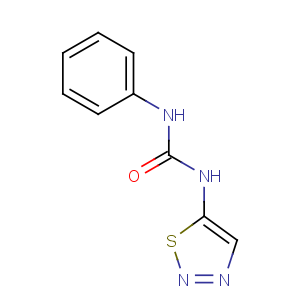Title: Thidiazuron
CAS Registry Number: 51707-55-2
CAS Name: N-Phenyl-
N¢-1,2,3-thiadiazol-5-ylurea
Synonyms: 5-(
N-phenylcarbamoylamino)-1,2,3-thiadiazole; thiadiazuron; TDZ
Manufacturers' Codes: SN-49537
Trademarks: Dropp (Bayer CropSci.); Ginstar (Bayer CropSci.)
Molecular Formula: C9H8N4OS
Molecular Weight: 220.25
Percent Composition: C 49.08%, H 3.66%, N 25.44%, O 7.26%, S 14.56%
Literature References: Non-purine containing urea derivative with cytokinin activity. Prepn: H. Schulz, F. Arndt,
DE 2214632;
eidem, US 3883547 (1973, 1975 both to Schering AG). Field trial in cotton: A. R. Hopkins, R. F. Moore,
J. Econ. Entomol. 73, 768 (1980). Effect of temperature and adjuvants on activity in cotton: C. E. Snipes, G. D. Wills,
Weed Sci. 42, 13 (1994). Review of effect on shoot formation and axillary shoot proliferation: C.-Y. Lu,
In Vitro Cell. Dev. Biol. 29P, 92-96 (1993); on woody plant tissue culture: C. A. Huetteman, J. E. Preece,
Plant Cell Tissue Organ Cult. 33, 105-119 (1993).
Properties: Crystals from isopropanol, mp 217° (dec). Very sol in DMSO, DMF, acetone, cyclohexanone, isophorone. Slightly sol in aliphatic and aromatic hydrocarbons and water.
Melting point: mp 217° (dec)
Use: Cotton defoliant; plant growth regulator in tissue culture.

